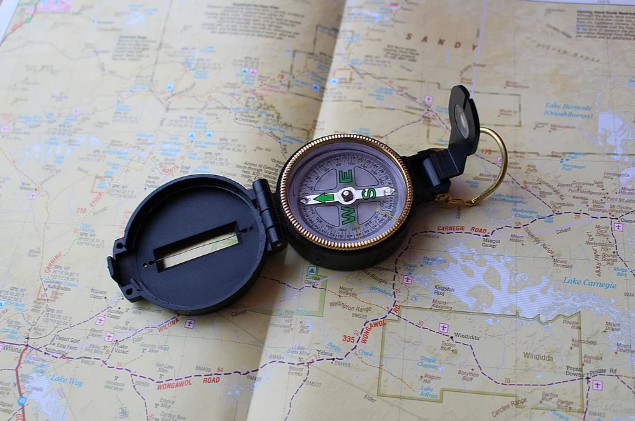Last Updated on October 11, 2022 by admin_hunter
Getting lost in the woods or desert is not fun. One way to get back to safety is using navigation apps on your mobile device to help you find your way. The problem with relying on your phone or tablet in such situations is that they can eventually fail. You could be lost in a place with poor service, or your batteries can lose their charge.
Learning how to use a lensatic compass could be a potential lifesaver. It is the military version of a simple compass, and it offers the advantage of being very accurate.
This quick guide will teach you how to use a lensatic compass. But first, let’s start with the correct way to hold the tool.
How to Hold a Lensatic Compass

A lensatic compass is incredibly precise, but it won’t do you much good if you don’t know how to hold it. If you hope to find your bearings (literally), you need to learn how to hold this military compass correctly for precision alignment.
The correct way to hold a lensatic compass is in both hands. Here’s how:
- Hold the compass in your dominant hand, with the side having the open slot facing up.
- Flip the lid or rear sight open to a 90-degree angle if you want to find the bearing of an object. If you want to read find a map direction, pull back the rear sight all the way until it is flat with the compass dial.
- Insert your thumb in the thumb ring and pull it back underneath the compass. With the exception of your index finger, wrap the others around your thumb for support.
- Place your index finger of the same hand along one side of the compass.
- Make an “L” shape using the thumb and index finger of your other hand. Steady the tool with the “L” shape so that the lensatic compass is wrapped in both hands.
- Hold the compass firmly and squarely in front of you.
How to Find the Bearing of an Object
Now that you know the correct way to hold the navigation tool, let’s learn how to use a lensatic compass to find the bearing of a distant object.
Assuming you see a power line off in the distance and you want to determine its bearing using a lensatic compass, here’s what you need to do.
- Flip the compass cover open, ensuring the rear sight is at a 90-degree angle or perpendicular to the base.
- Hold the compass in both hands as described in the previous steps.
- Turn the dial until it aligns with the sight wire that runs down the middle of the compass cover.
- Hold the compass up to your face, making sure it is steady and straight. You want the rear sight angled so that you can read the dial through the magnifying glass.
- Line your target (in this case, the power line) with the sight wire and read the degree marking. That’s your target’s bearing.
How to Follow Your Desired Direction
To travel in your desired direction, you need to first find your bearing. The goal is to move in a straight line using short distances until you get to your predetermined point. In military terms, this is known as shooting and following an azimuth.
To do this:
- Follow the procedure to hold your lensatic compass correctly and find a predetermined bearing.
- Bring the compass up to your face, maintaining a firm, steady grip.
- Turn your entire body with the compass (not only the compass) until your predetermined bearing comes under the fixed index line.
- Look through the sighting slot and locate a target that lines up with the sighting wire. A tree, tower, boulder, or any object will do just fine.
- Move to that object.
- Repeat the process until you get to your desired location.
Pro Tips for Using a Lensatic Compass

Safety
First things first; you need to understand the risks of using a compass in an unfamiliar location. A lensatic compass (or any type of compass for that matter) isn’t dangerous, but getting lost can be both dangerous and scary.
For this reason, you want to practice how to use a lensatic compass in familiar territory. If your backyard doesn’t offer plenty of features to practice with, head out to a local park.
Use Catching Feature
Even in a secured area like a park, you can still wander off course and drift far away during practice. It is a great idea to practice navigating in a place with catching features to prevent this from happening.
In case you are wondering what exactly catching features are, they are features that give you a general idea of where you are in relation to a location and help you know when you are getting too far off course. These features “catch” you before you travel out of the general area.
These features include fences, ditches, roads, streams, power lines, or even specific vegetation. If an area is bounded by a stream, it is easier to know when you are wandering too far off when you see the stream.
Have a Backup Navigational Aid
It is a good idea to bring a phone or tablet during practice. Make sure your device has a navigation app installed, and there is a good service where you choose to practice.
You may need to find your way back home with the help of your mobile device if you ever get confused.
Worst case scenario? Call for help! That means your phone should be fully charged before you head out into the woods.
Conclusion
Learning how to use a lensatic compass is not difficult if you can follow instructions. Make sure you keep the pro tips in mind during practice.
Start from your backyard and keep practicing until you can confidently shoot and follow an azimuth before heading out to the field.
FAQ
What is a declination adjustment?
The angle between true north and magnetic north is known as declination. It is usually east or west of magnetic north, depending on where you are. Suunto compasses, for example, provide either fixed or adjustable declination correction. Fixed declination correction is an additional scale under the compass needle. Declination adjustment is similar on a lensatic compass because the magnetic declination value in the map margin states the difference between true north and magnetic north.
What is the centerhold technique?
The centerhold technique is just one way you can hold a compass. For the centerhold technique, you place your thumb through the thumb loop and then form a base with your third and fourth fingers. You then extend your index finger along the side of the compass.
How do you use a lensatic compass for land navigation?
To use your lensatic compass for land navigation, hold the compass out in front of your nose, pick an object, and rotate your body to align the object with the sight wire. Make sure to rotate your entire body and not just the compass. You can then look through the magnifying glass to find the green line matched in the sight wire. Then locate the numbers on the inner dial.

